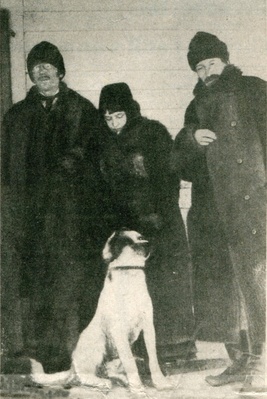 Stevenson, right, his stepson, left, and Fannie Osbourne, on the porch of the Baker Cottage. Adirondack Daily Enterprise, May 15, 1987
Stevenson, right, his stepson, left, and Fannie Osbourne, on the porch of the Baker Cottage. Adirondack Daily Enterprise, May 15, 1987 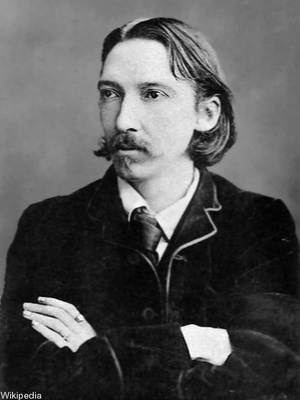 Robert Louis Stevenson Born: November 13, 1850
Robert Louis Stevenson Born: November 13, 1850
Died: November 3, 1894
Married: Fanny Van de Grift Osbourne
Robert Louis Stevenson was a Scottish novelist, poet, essayist and travel writer. His best-known books include Treasure Island, Kidnapped, and Strange Case of Dr Jekyll and Mr Hyde. A literary celebrity during his lifetime, Stevenson ranks among the 26 most translated authors in the world. 1 He spent the winter of 1887 and 1888 at the Baker Cottage overlooking the Saranac River near Moody Pond in Saranac Lake; his celebrity at that time played a significant part in the growing fame of Saranac Lake as a health resort. During the intensely cold winter Stevenson wrote some of his best essays, including Pulvis et Umbra, The Lantern Bearers and began The Master of Ballantrae.
Regarding Stevenson's health and the question of whether he was suffering from TB, Dr Jonathan H Cossar, retired Primary Care Physician from Glasgow, visited in 2013 with the Robert Louis Stevenson Society of Edinburgh and made this comment: "in my professional opinion, based on the history of RLS' illness from his writings and other sources, it was certainly compatible with the diagnosis of pulmonary tuberculosis causing lung damage - lung cavitations (bronchiectasis) this in turn pre-disposing to recurrent lung infections with fever, cough and coughing up blood (haemoptysis)."
Adirondack Daily Enterprise, May 15, 1987
Robert Louis Stevenson lived, worked and played in Saranac Lake a century ago 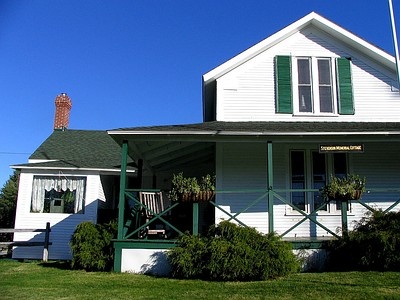 Stevenson Cottage - 2007
Stevenson Cottage - 2007 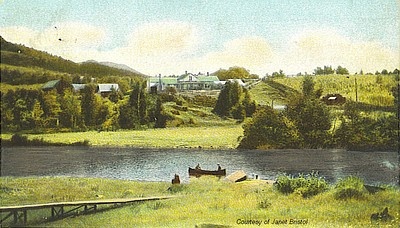 Stevenson Cottage - 1904
Stevenson Cottage - 1904  A brick at the Saranac Laboratory has been dedicated in the name of Robert Louis Stevenson by Jane and Charles Carroll.
A brick at the Saranac Laboratory has been dedicated in the name of Robert Louis Stevenson by Jane and Charles Carroll.
Scottish author came to cure, spent a cold winter in the Adirondacks — then left for the South Seas
What boy has not cherished his copy of "Treasure Island?" Clasping his prized book at bed time he could retire with exciting visions of Long John Silver and Old Pew, while slumber might bring dreams of pirate ships, tropical isles and buried treasure. Credit goes to Robert Louis Stevenson, that master writer of adventure tales who has thrilled readers of all ages with subjects ranging from "A Child's Garden of Verses" to "The Strange Case of Dr. Jekyll and Mr. Hyde." He has long been recognized the world over as the most popular author of, his day. And where could that great literary lion of 1887-88 be found — believe it or not, right here in Saranac Lake.
Chooses Saranac Lake over Colorado
Suffering from a chronic lung ailment, Stevenson was advised by his doctor to seek a more congenial climate. The Scottish author and poet had been residing in Bournemouth, England, at the time and the damp weather apparently was worsening his already frail condition. Colorado was suggested as a favorable destination, but upon his arrival in this country friends told him of the successful results being gained by Dr. E. L. Trudeau at his Adirondack Cottage Sanitorium for the cure of pulmonary tuberculosis. Since Saranac Lake was much closed than Denver, Stevenson elected to give it a try.
On or about the 3rd of October 1887, Stevenson arrived in the small settlement which, at the time, was described as "away on the other side of forty miles of tangled forest." In fact, an earlier writer, the Rev. Dr. J.P. Lundy in his book "Saranac Exiles," termed the place a "miserable hamlet." Be that as it may, Stevenson found living quarters in the Baker cottage for himself, his wife, his mother, his stepson, Lloyd Osbourne, and family servant, Valentine Roch. The cottage stood atop a small hill overlooking the Saranac River with Mt. Baker in the background. Andy Baker was an Adirondack guide and son of Col. Milote Baker, who ran a famous old hotel next to the Pine Street bridge. The road from the hotel to his son's cottage quite naturally became known as Stevenson Lane. Andy and his celebrated guest got along very well, since both men were inclined to avoid all frivolous pomp and ceremony.
Fast Friendship with Trudeau
As soon as Stevenson was settled in he called on Dr. Trudeau and placed himself in the doctor's care. This was the beginning of what was to become a firm friendship interspersed with sporadic and sometimes hectic arguments. Each respected the other's accomplishments, but each also held strong opinions which frequently were at variance. After a heated debate the two men would sometimes part in anger, but the next day cordial relations would resume as if the disagreement had never taken place. Years later, Trudeau often remarked that he wished he had spent more time with Stevenson when he had such splendid opportunities.
The noted author was a chain smoker and Mrs. Baker, when noticing cigarette burns on mantle, furniture and bed spreads, had grave apprehensions that her tenant might burn the house down. During one of his visits to his patient's quarters Trudeau found the room thickly layered with tobacco smoke, a condition which called to mind a similar structure where hams and bacon hung on hooks. He immediately informed Stevenson this was not the type of "cure" he had in mind.
In an opposite visit Stevenson called on Trudeau and met with an equally disagreeable condition. The doctor was showing the author his research lab where experiments in the growth of tubercle bacilli were under way. The unsightly scum in the test tubes combined with the odor from a kerosene incubator proved too much for Stevenson. While Trudeau was explaining his cultures in very explicit detail, he suddenly realized his visitor had fled the confines of the little laboratory. Suspecting what might have happened the doctor went in search of his illustrious patient. Out on the porch he found his visitor pale and nauseous, seeking some fresh air. The author turned with a sickly smite and said "Trudeau, I know - I know your lamp is very bright, but to me it smells of oil like the devil!"
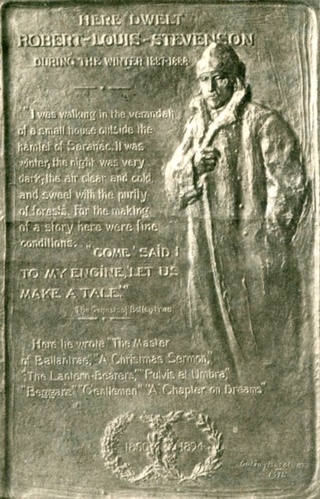 The Gutson Borglum tablet on the Stevenson Cottage. Adirondack Daily Enterprise, May 15, 1987
The Gutson Borglum tablet on the Stevenson Cottage. Adirondack Daily Enterprise, May 15, 1987
Popularity Quickly Grows
As soon as word was out that the famous Robert Louis Stevenson was a resident at Baker's, there was a constant siege on the place led for the most part by overzealous matrons seeking to beard the lion in his den. Stevenson abhorred all such social encounters and, when he observed a covey of admirers approaching, he and Andy would beat a retreat lay way of the back door. When winter set in these escape flights would invariably lead to the ice on Moody Pond, where the two men would don skates to enjoy the author's favorite sport. Andy often boasted of Stevenson's prowess on the steel blades claiming the author was the very best skater he had ever seen. His ability to cut all sorts of graceful figures on the ice amazed Andy because of his otherwise frail appearance. Apparently this one diversion was the only attempt at physical exercise which Stevenson enjoyed.
Trudeau finally talked his friend into accepting a dinner invitation from the Coopers, who had as their house guest the widow of General Custer. George Cooper had arrived from New York City three years earlier as one of Trudeau's first patients and, being quite wealthy, sponsored many of the doctor's projects. The Coopers had brought many superb furnishings from their city house to adorn their temporary home in Saranac Lake and, at he entered on the arm of Trudeau, Stevenson was overwhelmed by the room's opulence. There appeared a formal table setting replete with candles, glittering silverware and sparkling china, all of which was looked after by a uniformed butler. Whispering in the doctor's ear, Stevenson said, "These things frighten me." During the dinner conversation Mrs. Custer advised the author that he should put a "real woman" in his next novel. Stevenson replied, "Madam I have little knowledge of Greek."
A later writer to arrive in Saranac Lake, under circumstances similar to Stevenson's, was Stephen Chalmers, who wrote an account of the Scot's stay here entitled "The Penny Piper of Saranac." He claimed that when the famous author was not busy writing he was tooting on a penny whistle, a habit which apparently didn't please the Bakers. Mrs. Baker was to remark to Andy, "He tootles the whistle better'n he plays the piano," to which her husband replied: "And a sight oftener!"
Mrs. Estella Martin, wife of the famous guideboat builder William Allen Martin, was an active member of St. Luke's Church and she hoped to capture Stevenson to act as the guest of honor at a fundraising dinner at the Berkeley Hotel. Stevenson flatly refused. Undaunted, Mrs. Martin approached the author's mother with the plan and received full assurance that the party could take place. Once more Stevenson was adamant in his refusal, but his mother told the church group to go ahead with the preparations and she would see to it that her son would show up. Tickets sold like hot cakes! On the evening of the affair she made good on her promise but the author arrived in such a state of severe grouch that the festivities seemed doomed. Some sympathetic men present ushered Stevenson to a side room, where a generous dose of an un-churchlike libation was administered to the hostile guest. Soon Stevenson was mixing with the gathering and after dinner even gave a speech, something which he had always refused to do in the past. Those present claimed the speech was presented "as only Stevenson could talk," but unfortunately no record was made of the subject matter.
Memorable Works Produced Here
During his brief stay here the author managed to turn out some of his most important works. He had been commissioned by Scribner's Magazine to produce a dozen essays in return for a fixed fee of $3500. His prolific pen turned out such favorites as "The Lantern Bearers," "Beggars," "A Christmas Sermon" and. "Pulvis et Umbra" among others. He also completed the major portion of "The Master of Ballantrae" while here and collaborated with his stepson on a mystery novel, "The Wrong Box." He composed a poem called "Winter" no doubt inspired by the frigid temperatures of the area.
Perhaps it was the cold climate which induced Stevenson to seek the warmth of the south seas, or perhaps it was just a case of wanderlust. In any event, on April 16, 1888, he left Saranac Lake, for San Francisco, where his wife had chartered a yacht. In June they set sail for Honolulu where he put the finishing touches on The Master of Ballantrae. From Hawaii they sailed to Samoa in the South Pacific, where Stevenson died in 1894.
While Stephen Chalmers was writing "The Penny Piper of Saranac" he was visited by the New York editor Robert H. Davis, who was surprised to learn of the important works which Stevenson had turned out while he was here. Davis thought some sort of memorial was in order to commemorate the author's stay at Saranac Lake.
He engaged Gutzon Borlum, the noted sculptor who would later create the Mt. Rushmore presidential busts, to produce a bas-relief in bronze. Burglum, who also was a Stevenson fan, donated his services in the execution of a suitable tablet. What better place to mount the plaque than on the Baker Cottage? A committee which had been formed to handle the memorial soon expanded into the Stevenson Society and a membership campaign was very soon successful.
On Oct. 30,1915, before a sizeable crowd, Mrs. Baker unveiled the Borglum plaque which had been mounted on the veranda where Stevenson had often paced. Present at the ceremony, among the many notables, was New York Governor Charles Whitman. Three years later the Stevenson Society was able to purchase the Baker cottage and open it to the public with a visitor count of over one thousand for the first season.
Over the ensuing years the little cottage suffered many ups and downs. A changing of the guard had taken place. Such influential patrons as Chalmers, Davis, Col. Walter Scott, Sir Harry Lauder, William Morris, C.M.Palmer Will Low, together with Drs. Trudeau, Baldwin, Kinghorn, and Brown, were amongst us no more. A steady decline in the maintenance of the property led to village acquisition of the cottage in 1951. Three members of the Delahant family served sueessively 'as curators and a.revised interest in the memorial resulted in a record seasonal attendance of five thousand visitors, many from foreign countries.
As a big boost for Saranac Lake may the little cottage always be open to welcome those many admirers, of the beloved author from Scotland, who came to the tiny hamlet beyond the tangled forest a century ago this October.
Adirondack Daily Enterprise, June 17, 2006
Stevenson's Saranac Lake connection
By MIKE LYNCH, Enterprise Staff Writer
Perhaps remembered best by one of his Saranac Lake hosts for the cigarette-burn marks he left on the fireplace mantel, Robert Louis Stevenson was often depicted as a reclusive man during his stay in the Adirondacks during the winter of 1887-'88. ' "He wasn't well and pretty much kept to himself," Mary Baker told New York Sun Columnist Bob Davis in 1915. "When not at work, he took long walks, played the flute now and then and smoked a good many cigarettes. He used to set the lighted things along the edge of the mantel."
Now, about 90 years after that statement, those cigarette burns not only remain but they are an integral part of Stevenson oral history in Saranac Lake, which is likely to be the talk of the town next month.
From May 18 to 20 Saranac Lake will be host to "Transatlantic Stevenson," an international conference organized, by-Stevenson scholars Prof Ann Colley from the State University of New York at Buffalo and Prof. Martin Danahay from Brock University in Ontario, Canada. The Robert Louis Stevenson Society of America is the sponsor.
The conference will feature a variety of speeches, scholarly panels, movies and theatrical performances, some of which will likely appeal to the more scholarly Stevenson fans and others that will be attractive to a wider audience.
The conference will feature activities such as a showing of the 1912 film version of Dr. Jeckyll and Mr. Hyde and a piper's parade by the Elgin and District Pipe Band to the Stevenson Memorial Cottage.
"For the society, it rekindles what the society is trying to promote," said Robert Louis Stevenson Society of America Vice President Don Paulson.
The keynote speaker will be Stevenson biographer Jenni Calder of Edinburgh, Scotland. The theme of her speech: "I Should Like to be an American: Scots in the, USA."
Denahay characterized the visiting group as "a roaming band of Stevenson Scholars."
Of course, that falls in line with Stevenson's travelling lifestyle. "There are bits and pieces of him all across the globe," Denahay said.
In the past, the group has held its conference in places such as Stevenson's birthplace of Edinburgh, Scotland. But the conference, which is held every two years, has also traveled to places like Milan, Italy, which has no connection to Stevenson but is the home of one of the Conference's top members.
Stevenson himself visited America on two occasions. During his first visit in 1879, he wasn't a successful author yet. And when he spent his honeymoon in Calistoga, Calif. he couldn't afford the expensive hotels, so he went up to an abandoned mining town where he squatted. The experience was later told through his novel, Silverado Squatters.
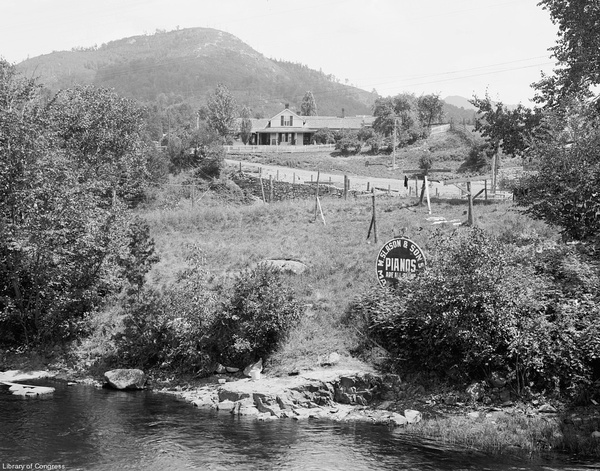 Stevenson Cottage, between 1900 and 1910, Detroit Publishing
Stevenson Cottage, between 1900 and 1910, Detroit Publishing
His trip in 1887 was a whole different story. Stevenson came to Saranac Lake on Oct. 3 and left in mid-April. It was a difficult time for Stevenson but a good one, too. Just months before his arrival, in May of 1887, Stevenson lost his father, Thomas. But during the same time period, the author had been growing in acclaim as several of his recent works had found success. Kidnapped, Treasure Island and The Strange Case of Dr. Jeckyll and Mr. Hyde came out in the years leading up to his Saranac Lake stay.
Stevenson's decision to come to Saranac Lake wasn't part of his original plans. Around the time of the death of his father, Stevenson's doctor recommended that Stevenson, whose health was failing and who had a life history of lung ailments that may or may not have been tuberculosis, leave his native country of Scotland to receive treatment Colorado Springs.
With his American wife, Fanny Osbourne; her son, Lloyd; the family's French-Swiss maid, Valentine Roch; and Stevenson's then recently widowed mother, Margaret, the author left on his journey.
In New York, Stevenson decided to forego his trip to Colorado Springs after he heard about the reputation of Dr. Edward Livingston Trudeau. Upon learning of Trudeau's success with tuberculosis patients, the author decided Saranac Lake would he a good place, to not only get back his health, but get away from the crowds that he was now drawing due to his celebrity.
Soon after the decision, Stevenson sent Fanny and Lloyd to find a house. What they found was a small cottage owned by the Bakers, out of which Andrew Baker ran a guide-service for hunters and outdoorsmen. The building overlooked the Saranac River, with what is now known as Mount Baker sitting in the background.
The Stevenson crew rented out a wing of the house. While in the house, Stevenson often kept to himself, smoking cigarettes and working on his writing. Among those items that he wrote were 12 essays for Scribner's magazine for a total of $3,500 and the first two-thirds of The Master Of Ballantrae. He also wrote a poem titled "Winter," sitting in front of the fireplace.
His stay of a little more than six months was short but it marked an important time period in between two chapters of his life — the old one and the new one. After leaving Europe for America in 1887, he never did return. Instead, after leaving Saranac Lake, he embarked on a journey to the South Pacific, where he would spend a little less than a decade before dying on Dec. 3, 1894.
While in Saranac Lake, Stevenson was often reclusive, seeing most guests only on Saturdays, although he did socialize occasionally and did enjoy ice skating on Moody pond, There are various reasons given for this, including his poor health. He was also adjusting to fame and was reluctant to entertain strangers looking for the celebrity author. In the South Pacific, he was more outgoing, which is more consistent: with his lifetime traits.
His popularity in Samoa was evident by the account in the local newspaper after his death.
"Vailima is in mourning for the head of its clan who now looks down upon his sorrowing relatives from the lofty site on which his remains have been placed to rest," wrote the Samoa Times on Dec. 8, 1894."He is dead, it is true, yet he lives in his works, which will perpetuate his name and memory through generations."
Although when Stevenson left Saranac Lake he never did return, many of his belongings found their way back to the Adirondacks. Today, the museum, which was built as a home for the Baker family in the middle of the 19th century, boasts one of the best, if not the best, collection of Stevenson artifacts, Museum curator Mike Delahant said.
This summer, to coincide with the Stevenson Conference, the museum will have new displays, many of which will have items, that have not been seen publicly in decades.
"We were planning to do it anyway," Delahant said. "But the conference gives us that much more incentive." The museum's collection boasts artifacts that go back to Stevenson's youth in addition to items he used during his stay. Among its many items are four scrapbooks of newspaper clippings put together by Stevenson's mother, a photo album from his youth, playing cards he used the day he died, and even a lock of his platinum blond hair from when he was an infant.
Many of the items were donated during those early years of the museum when Stevenson's stepson, Lloyd, returned to the place to donate personal items of the great author.
"The kind of stuff that other museums drool over," Delahant said.
When the Stevenson Society was established in 1915, it had a strong Core of members. Among those helping the museum get on its feet in the early days were Samuel McClure, founder of McClure's Magazine and the first newspaper syndicate in America, and Gutzon Borglum, the sculptor responsible for Mount Rushmore. But it might never have happened, had it not been for the 1915 visit of Davis and his friend, Stephen Chalmers, who later wrote "The Penny Piper of Saranac" about Stevenson.
Although the pair received some less-than-positive remarks from Mrs. Baker about Stevenson, especially in regard to the author's smoking habits, they were inspired by the visit.
Davis recalled the account of the pair walking away from the cottage in his column. One sentence says it all: "Let's rent those two rooms, I suggested, and turn the Baker Cottage into a Stevenson shrine."
More than 80 years later, that's what has happened.
Comments
Footnotes
1. Wikipedia: Robert Louis Stevenson



